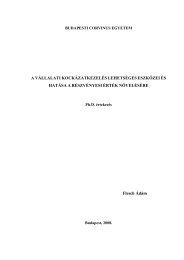Jenei István
Jenei István
Jenei István
Create successful ePaper yourself
Turn your PDF publications into a flip-book with our unique Google optimized e-Paper software.
<strong>István</strong> <strong>Jenei</strong>: Lean transformation of hospital processes – Structuring foreign and Hungarian experiences,<br />
PhD Dissertation, Corvinus University of Budapest, Doctoral School in Business Administration<br />
1983, the author was present at a special forum organised with the participation of many<br />
theoretical and practical experts interested in the topic. One of the significant<br />
achievements of the forum was that it provided a valid definition of the interrelationship<br />
of TQC (later on TQM) and JIT/lean, viz. that "they were mutually supportive co-<br />
equals” (Schonberger, 2007. p.408.).<br />
Essentially the same position is shared by Dahlgaard – Dahlgaard (2006), who<br />
emphasise that lean management supports the general theses of TQM. Shimokava and<br />
Fujimoto (2009), on the other hand, speak of the role played by TQM within the Toyota<br />
Production System.<br />
In what follows, I shall use the results of two research projects to specify the<br />
relationship of the two systems, which I shall compare with the findings of the Shah-<br />
Ward (2007) research described in Section 1.3.<br />
The first research, the findings of which I shall represent considers the<br />
relationship of TQM and lean in two dimensions, production practices and performance<br />
(Flynn et al., 1995). The article defines the typical practices of each of the two systems<br />
and examines their respective and combined performances. What is important for our<br />
purposes here is the practices associated with the systems. Flynn, Sakakibara and<br />
Schroeder identified three classes of practice: JIT-specific practice, TQM-specific<br />
practice and so-called “infrastructural” practice, which essentially means the<br />
intersection of TQM and JIT practice. The attribute “infrastructural” was inspired by the<br />
common features of the practices concerned: according to the authors they represent the<br />
basis of both systems. The classification of the various practices by Flynn et al. (1995)<br />
is shown in the second column of Table 1.<br />
- 25 -

















